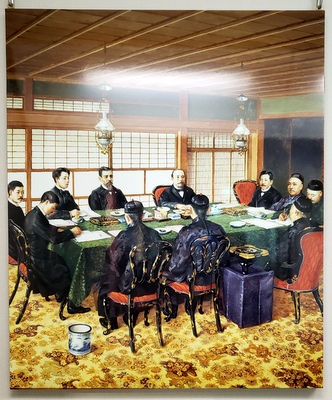Treaty of Shimonoseki

- Signed: 17 April 1895
- Japanese: 下関条約 (Shimonoseki jôyaku)
The Treaty of Shimonoseki, signed April 17, 1895, marked the end of the Sino-Japanese War.
The officials who negotiated the treaty included Prime Minister Itô Hirobumi and Foreign Minister Mutsu Munemitsu of Japan, and Chinese ambassador Li Hongzhang.
In the treaty, China renounced any claims to suzerainty in Korea (i.e. claims of Korea being a tributary, or otherwise subordinate to or specially linked with China), and formally recognized Korea as an independent state. The Qing Court also ceded Taiwan and the Pescadores Islands (C: Penghu) to Japan, granted Japan most-favored-nation status, and officially opened an additional seven Chinese trade ports to Japanese trade, as well as agreeing to pay considerable monetary reparations, in British pounds sterling.[1] The indemnity paid by the Chinese was equivalent to roughly 364,510,000 yen, roughly one-third of Japan's total GNP at the time, and far more than making up for the cost of the war to the Japanese government, expenses totalling around 200,476,000 yen.[2]
Having obtained most-favored-nation status meant, to a considerable degree if not completely, treaty equality with the Western powers, and the successful resolution of the Meiji government's long-time aims of renegotiation of the unequal treaties. The terms of the treaty also allowed Japan to begin building factories in China's treaty ports, protected by extraterritoriality.[3]
The Treaty also stipulated that China cede to Japan the Liaodong Peninsula, which extends into the Yellow Sea opposite the Shandong Peninsula and just north of the China-Korea border. However, due to the Triple Intervention of Russia, Germany, and France, which feared the growth of Japanese power/influence, and which desired access to Liaodong for their own spheres of influence, Japan was ultimately denied control of that territory.
References
- Okinawa ken heiwa kinen shiryôkan sôgô annai 沖縄県平和祈念資料館総合案内 ("General Catalog of Okinawa Peace Memorial Museum"), Nanjô, Okinawa: Okinawa Peace Memorial Museum (2004), 22.
- ↑ Peter Duus, "Economic Dimensions of Meiji Imperialism," in Peattie and Myers (eds.), 134.
- ↑ Duus, 143.
- ↑ Marius Jansen, China in the Tokugawa World, Harvard University Press (1992), 110.